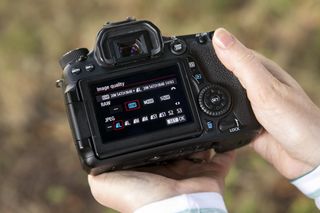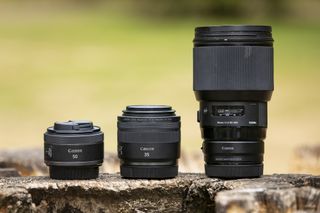Portraiture photography is fantastic way of sharpening both your camera and social skills, and allows you to experiment with both studio flash as well as natural light. It can however seem like a dark art, how do you light your subject, get the best poses out of them and what kit should you use?
This month we aim to answer all of these questions and more! We teamed up a reader of PhotoPlus: The Canon Magazine (opens in new tab), Carole Stevens, for a masterclass in portraiture with portrait pro Rebecca Faith at her local park in the beautifully picturesque city of Bath, England.
Rebecca, 46, is professional portrait and wedding photographer based in Somerset. Her photographic journey began after travelling around the world with her camera following her degree, where she specialized in photography. In her 20-plus years as a pro, she’s built up a portfolio of clients, including international corporations, and she’s shot everything from big weddings to private parties and public figures. Check out her website here (opens in new tab).
Before you get started, you might also like to look at the best lenses for portrait photography (opens in new tab) – prime lenses that help you to get frame-filling portraits.
1. Auto to Av mode
(opens in new tab)
Carole was used to relying on Auto mode because she didn’t feel confident with the exposure settings. Rebecca gave her some guidance and showed her how to use Aperture Priority mode for more control. “To help Carole control her aperture for nice-looking portraits, I got her using Av mode. Setting a wide aperture of around f/4 enables her to get sharp subjects with blurred backgrounds, which helps them stand out in the scene,” says Rebecca.
2. RAW is best
(opens in new tab)
“I always shoot in the Raw setting (opens in new tab) on all my Canon cameras,” says Rebecca, “as it gives you much more scope when editing the images afterward. With a Raw image, you can quickly change things like the exposure, white balance and shadows without damaging the image quality.” However, as Carole wasn’t confident editing Raw images just yet, Rebecca set her camera to capture Raw and JPEGs. That way, she had JPEGs, plus Raw files if she needed them to play with in Photoshop (opens in new tab).
3. Shoot in the shade
(opens in new tab)
One of the biggest mistakes beginners make is trying to photograph people in bright sunshine. “You want to avoid ‘top light’ with the sunlight from high above as it creates nasty shadows on people’s faces, as well making them squint,” says Rebecca. “Just a few steps under tree cover is OK, then the light is softer and comes from a lower level.”
4. Canon full-frame mirrorless camera
(opens in new tab)
Becky’s gone mirrorless and updated her Canon EOS DSLRs to an EOS R (opens in new tab) and EOS R6 (opens in new tab). “I love the smaller bodies, and the EVF is brilliant – especially in the R6, so I can see how my photos will look before I take a shot,” says Rebecca, “I love the EOS R6 for portraits as it has improved AF, including Eye Detection AF.”
5. Collapsible reflectors
“Reflectors (opens in new tab) are a small, quick and cheap way to brighten up your subjects, as they’re great for bouncing light back to fill in ugly shadows. This gives a soft light compared to lights, which can be too harsh and take more time to set up,” says Rebecca. “This Lastolite one is silver for cooler reflected light, and sunfire for a warmer light.”
6. Prime lenses
(opens in new tab)
Rebecca used to rely on zooms but recently has been using primes more often for portraits. “My primes are all fast lenses with wide maximum apertures from f/1.4 to f/1.8, which helps capture beautiful bokeh and brilliantly sharp shots,” she says, “I carry Canon’s smaller RF 50mm F1.8 STM (opens in new tab) and RF 35mm F1.8 Macro IS STM (opens in new tab) budget primes, plus a Sigma 85mm f/1.4 Art lens, a big but fast prime.”
7. Advanced AF settings
The latest Canon EOS mirrorless cameras, such as Rebecca’s EOS R6, have very advanced AI autofocus to make it easier to lock focus on different subjects. Using a single AF point on her R6, and AF modes in the pink menu with Servo AF, Eye Detection enabled and Subject set to People, her camera finds the subject’s eyes, even if shooting through scenery or other objects are on the same focal plane. Seriously clever stuff!
8. White balance
(opens in new tab)
Getting the white balance (opens in new tab) bang on ensures your shots look right. “I noticed Carole was using Auto White Balance (AWB) but this can vary the color temperature of her images, depending on where she’s shooting and the amount of sunlight in the shot,” says Rebecca. “I suggested using the Daylight or Shade presets when shooting under trees in the shade for more accurate WB.”
9. Camera holster
“I’m often on the move when taking portraits and like to have my two cameras to hand to avoid missing a moment or stalling the shoot,” says Rebecca. “I use dual Spider camera holsters on a belt, which come with attachments for the base of my cameras, so I can securely slot them in and out quickly. I use them with my EOS R with RF 50mm F1.8 STM lens, and my EOS R6 with a longer Sigma 85mm f/1.4 Art (opens in new tab) lens.”
10. Selectively adjusting colour temperature
“I shoot in Raw and this makes it very easy to adjust the white balance in Photoshop,” explains Rebecca. “Note that when shooting under trees, the green foliage can cause a colour cast, so I often add a little magenta to people selectively using the Radial Gradient tool in Adobe Camera Raw, using the Temperature and Tint sliders in the Colour section.”










